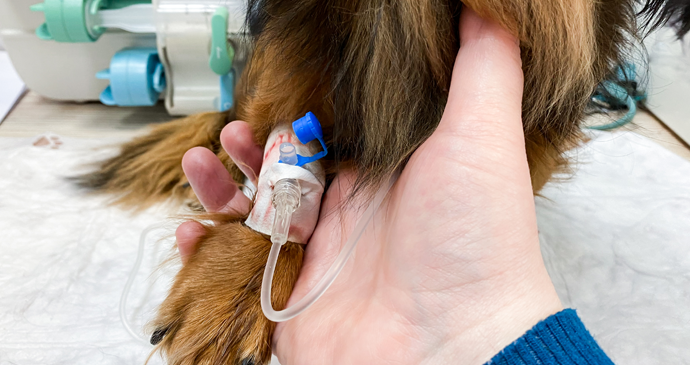If you're a vet tech still using gravity drip sets and manual calculations, you’re part of a large group of professionals stuck doing far more work than you should be. You're constantly running back to check fluid rates. You're setting timers. You're doing mental math at 2 AM with an emergency patient. Meanwhile, your friends at other practices are outsourcing the burden of that manual work to their fluid pumps.
Our 2025 Veterinary IV Pump survey made something crystal clear. Despite occasional equipment-related headaches, not a single respondent wanted to go back to the pre-pump days.
This blog is your practical guide to convincing your practice manager that IV pumps aren't just convenient. They don’t just ease the stress you feel day-in-day-out. They're hugely impactful on common workflows, patient care, and yes, the bottom line they care about.

Your three most compelling arguments for IV pumps
1. Time is money
Here's a quick calculation.
How many fluid therapy patients does your practice see in a typical week? Now multiply that by the number of times you check each bag (probably at least 4-6 times per hour). Then calculate how many minutes each check takes.
The math gets scary fast. If you have just three patients on fluids and spend 2 minutes per check, that's 36-54 minutes spent on something a machine could do automatically.
Our survey found that 60% of veterinarians strongly agreed that managing multiple patients on fluids creates significant workflow challenges. As a veterinarian and clinic owner from Tampa explained, "Sharing pumps between rooms causes delays if the units aren't immediately available. My staff hustles to avoid any bottleneck, though it still adds stress to an already busy schedule."
How to frame it to your manager:
"If we invested in IV pumps, I could redirect those hours toward revenue-generating activity like more appointments, lab work, or client communication that builds relationships. That's potentially tens of thousands of dollars in additional revenue annually, and a return on investment of 7X or more.”
2. Precision equals better patient outcomes (and more repeat customers, and more referrals…)
In our survey, 87% of vets agreed that infusion pump workflows vary significantly between routine procedures and critical care. That's because there’s less wiggle room in emergencies.
A vet from Atlanta responded to our survey saying, "In emergencies like a dog with severe heatstroke or a cat in shock, we follow different protocols that are less defined. We're adjusting rates constantly, monitoring vitals closely, and sometimes switching fluids or meds on the fly."
Manual drip sets can't match the accuracy of programmable pumps especially when rapid adjustments are needed. Every drop matters, particularly for smaller patients where even slight miscalculations can have consequences. It’s stressful for you in these scenarios!
But here's the thing most techs don't mention when asking for pumps. Better outcomes mean clients who come back and clients who tell their friends. When Mrs. Johnson's cat recovers quickly from a procedure, she’s grateful. When Mr. Smith's dog doesn't seems happier following a challenging visit to your clinic and makes a quick recovery, he tells his family and friends about it.
When the equipment works, the treatment works. And when the treatment works, clients are your advocates.
How to frame it to your manager:
"IV pumps are proven to improve recovery times and lead to fewer complications during and after procedures. Clients definitely notice when their pets recover smoothly, and that translates directly into loyalty and word-of-mouth referrals. It's a medical advantage and a marketing advantage."
3. Modern equipment creates client confidence
A full 81% of survey respondents agreed that equipment malfunctions impact client satisfaction and clinic reputation. The flip side is equally true: modern, professional equipment builds client trust.
When clients see antiquated methods being used, they wonder what other aspects of care might not be up to date. Conversely, seeing modern equipment reassures them their pet is receiving state-of-the-art care.
As Nicole from Sacramento noted in our survey: "Clients appreciate knowing that every aspect of their pet's care is supported by equipment that isn't 30 years old."
How to frame it to your manager:
"Clients notice the equipment we use. Having modern IV pumps signals that we're committed to the highest standard of care, which helps with client retention and word-of-mouth referrals."
Making your case with 5 steps
Step 1
Do some homework (so it’s already done for your boss)
Before approaching your practice manager:
Research specific models and ger pricing (start with any of these patient-ready IV pumps).
Calculate exactly how much time your team currently spends on manual fluid administration.
Identify which specific tasks you could take on with that freed-up time.
Find out if any nearby competing practices already use pumps.
Step 2
Speak the language of ROI
Practice managers care about return on investment. When making your case:
Focus on efficiency gains (more patients seen per day).
Highlight potential revenue increases from freed-up tech time.
Mention risk reduction (fewer fluid administration errors).
Note the reduced stress and burnout for staff (remember, staff turnover is expensive).
Our survey found that 94% of vets consider cost the critical factor in equipment decisions. Be prepared to discuss both immediate costs and long-term benefits.
Step 3
Suggest a phased approach
If budget is tight, propose starting with just one or two pumps:
Begin with use in surgery/recovery where precision is most critical.
Track time savings and outcomes to build the case for more units.
Consider refurbished equipment as proactive way to reduce the initial cost (the majority of our survey respondents consider this a viable option).
Step 4
Address common objections
Be ready with answers to likely concerns:
"They're too expensive" → Focus on ROI and phased implementation.
"We've always managed without them" → Highlight evolving standards of care and plateaus to business growth.
"They seem complicated" → Mention 73% of vets in our survey get all the training they need from documentation included with their purchase.
Step 5
The follow-up
If you don't get an immediate yes:
Ask what specific information would help them make the decision.
Suggest visiting another practice that uses pumps.
Offer to create a simple one-page proposal showing projected cost savings.
Document and share instances where manual methods caused delays or issues.
Schedule a follow-up conversation with any additional data they requested.
The bigger picture includes evolving standards of care
Our survey showed that 86% of practices are seeing increased demand for specialized care that requires precise fluid delivery. As veterinary medicine advances, equipment needs change too.
One respondent said, "We are treating more complex cases now. I have seen an increase in patients who require tailored fluid therapy such as those with cancer or severe infections."
By investing in IV pumps, your practice is managing the workload better and preparing for the future of veterinary medicine.

You're the one using it every day
As the person on the front lines of patient care, your perspective on workflow tools matters. You're not asking for a break room foosball table. You're interested in equipment that directly impacts patient care, practice efficiency, and profitability.
Be confident in making your case, backed by the knowledge that thousands of veterinary professionals across the country consider these tools essential.
Want more data to support your case?
Ask for a copy of our complete 2025 Veterinary IV Pump Survey Report and share the most relevant findings with your practice manager.